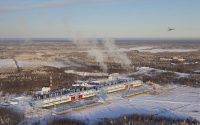Oil price instability as drone strikes shock word markets
The recent drone attacks on Saudi Arabia’s oil processing complexes have had a sudden and marked impact on the world’s crude oil prices. With up to 5% of the world’s crude oil supply wiped out in the attacks, this has caused one of the biggest and most sudden shocks to the oil market in recent history.
Drone attacks hit Saudi Arabia’s oil processing and production complexes in Khurais and Abqaiq on 14th September. Claimed by Houthi’s in Yemen fighting a bloody civil war against Saudi influence, the attack caused huge fires within Saudi Arabian oil refineries which took hours to control. Both facilities have been shut down to implement repairs and are expected to be operational by the end of the month. Nevertheless, the attack has cut Saudi Arabia’s oil production capacity in half. This is a major shock; Saudi Arabia is the globe’s biggest exporter of oil, controlling roughly 10% of all daily global oil production. As such, this attack has wiped out 5% of the world’s oil supply.
Saudi Arabia’s stock market immediately fell following the attacks. Elsewhere, Brent crude oil prices surged up almost 20% in the aftermath. Markets calmed somewhat over the following days as energy ministers in Saudi Arabia attempted to assuage fears by stating export levels would remain the same, with the country relying on reserve oil supplies. Nevertheless, oil prices, particularly the benchmark Brent crude, are still surging and fluctuating following the attack.
Brent crude oil surged 19% to $71 immediately after the attack before steadily falling over the following days to about $65 a barrel on Wednesday 18th. This is the largest oil spike in some three decades and has been compared to both 9/11 and the Kuwait oil fires of 1991. US crude oil prices soared too (up 15%), with fears of price instability leading traders to scramble for new oil contracts. In the ongoing aftershocks to the oil price surge, stock markets in the Asia-Pacific, particularly China, fell some 1.68%. Economists have noted that instability and disruption could continue for weeks — if not months — unless the Saudi’s can get their facilities fully back online soon. A chief strategist at FXTM, Hussein Sayed, expects that oil prices could even potentially hit $100 a barrel, a scenario which was hitherto unimaginable.
A key uncertainty hinges upon geopolitical risk premiums as markets will begin to respond to the potential vulnerability of Saudi Arabia’s oil supply. This has not been helped by ongoing geopolitical tensions between the US and Iran, the latter of which has been accused of abetting the attack. With that being said, most analysts believe that a more prolonged and severe shock to energy markets is unlikely. This, in part, is because of the recent concern with oversupply rather than shortages in the past year from OPEC. OPEC producers, particularly Russia and Saudi Arabia, had previously called for (and implemented) production cuts to prop up falling oil prices.
The recently upped price of oil per barrel means that petrol pumps in the UK could see a rise between 3 to 4p per litre. The next few days, weeks and months will be the most important in terms of relaying market response. Oil price instability will be tied both to Saudi Arabia’s ability to repair their facilities and any potential political or military responses to the attack. If the oil facilities are fixed promptly, as Saudi officials suggest by the end of the month, we might expect oil prices to rise only $2 – $3 a barrel.
As new details and potential repercussions from the attack play out, the global economy will react accordingly. One thing is for sure, the blow caused by the attack is stunning, causing the most significant disruption in oil production from the world’s largest — and most reliable — exporter of oil. All eyes are on how Saudi Arabia, the US and Iran will react to the events.


